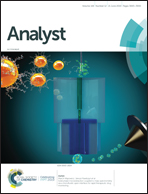Rolling circle amplification-mediated in situ synthesis of palladium nanoparticles for the ultrasensitive electrochemical detection of microRNA†
Abstract
Herein, an ultrasensitive and label-free electrochemical biosensor was developed for microRNA (miRNA) based on rolling circle amplification (RCA)-mediated palladium nanoparticles (PdNPs). The sensor was fabricated by immobilizing dual-functionalized hairpin probes onto an electrode. The specific recognition of target miRNA-21 by the hairpin probes could trigger the RCA reaction, which produced numerous guanine (G)-rich long single-stranded DNAs (ssDNAs). Based on the interaction of the PdII species with the nitrogen atoms of the G bases, these G-rich long ssDNAs served as specific templates in the in situ synthesis of massive PdNPs as electrochemical indicators. The formation of PdNPs was demonstrated to be exactly along the RCA products by high-resolution transmission electron microscopy. Using this cascade signal amplification strategy, the developed biosensor achieved a linear range of 50 aM–100 fM with an ultralow detection limit of 8.6 aM miRNA-21. Furthermore, the developed biosensor exhibited good selectivity, reproducibility, stability and satisfactory feasibility for miRNA-21 detection in human serum samples; this ensured significant potential of this biosensor in disease diagnosis and prognosis applications.



 Please wait while we load your content...
Please wait while we load your content...